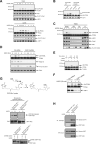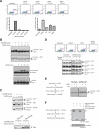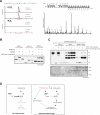Deubiquitinases as a signaling target of oxidative stress
- PMID: 23219552
- PMCID: PMC3534866
- DOI: 10.1016/j.celrep.2012.11.011
Deubiquitinases as a signaling target of oxidative stress
Abstract
Deubiquitinating enzymes (DUBs) constitute a large family of cysteine proteases that have a broad impact on numerous biological and pathological processes, including the regulation of genomic stability. DUBs are often assembled onto multiprotein complexes to assist in their localization and substrate selection, yet it remains unclear how the enzymatic activity of DUBs is modulated by intracellular signals. Herein, we show that bursts of reactive oxygen species (ROS) reversibly inactivate DUBs through the oxidation of the catalytic cysteine residue. Importantly, USP1, a key regulator of genomic stability, is reversibly inactivated upon oxidative stress. This, in part, explains the rapid nature of PCNA monoubiquitination-dependent DNA damage tolerance in response to oxidative DNA damage in replicating cells. We propose that DUBs of the cysteine protease family act as ROS sensors in human cells and that ROS-mediated DUB inactivation is a critical mechanism for fine-tuning stress-activated signaling pathways.
Copyright © 2012 The Authors. Published by Elsevier Inc. All rights reserved.
Figures



Similar articles
-
Deubiquitinating enzymes (DUBs): Regulation, homeostasis, and oxidative stress response.J Biol Chem. 2021 Sep;297(3):101077. doi: 10.1016/j.jbc.2021.101077. Epub 2021 Aug 12. J Biol Chem. 2021. PMID: 34391779 Free PMC article. Review.
-
Reversible inactivation of deubiquitinases by reactive oxygen species in vitro and in cells.Nat Commun. 2013;4:1568. doi: 10.1038/ncomms2532. Nat Commun. 2013. PMID: 23463011 Free PMC article.
-
Regulation of monoubiquitinated PCNA by DUB autocleavage.Nat Cell Biol. 2006 Apr;8(4):339-47. doi: 10.1038/ncb1378. Epub 2006 Mar 12. Nat Cell Biol. 2006. PMID: 16531995
-
Regulation and cellular roles of ubiquitin-specific deubiquitinating enzymes.Annu Rev Biochem. 2009;78:363-97. doi: 10.1146/annurev.biochem.78.082307.091526. Annu Rev Biochem. 2009. PMID: 19489724 Free PMC article. Review.
-
Harnessing the oxidation susceptibility of deubiquitinases for inhibition with small molecules.Angew Chem Int Ed Engl. 2015 Jan 7;54(2):599-603. doi: 10.1002/anie.201408411. Epub 2014 Oct 19. Angew Chem Int Ed Engl. 2015. PMID: 25327786
Cited by
-
Deubiquitinases Maintain Protein Homeostasis and Survival of Cancer Cells upon Glutathione Depletion.Cell Metab. 2019 May 7;29(5):1166-1181.e6. doi: 10.1016/j.cmet.2019.01.020. Epub 2019 Feb 21. Cell Metab. 2019. PMID: 30799286 Free PMC article.
-
Using Quantitative Spectrometry to Understand the Influence of Genetics and Nutritional Perturbations On the Virulence Potential of Staphylococcus aureus.Mol Cell Proteomics. 2017 Apr;16(4 suppl 1):S15-S28. doi: 10.1074/mcp.O116.065581. Epub 2017 Feb 14. Mol Cell Proteomics. 2017. PMID: 28196877 Free PMC article.
-
The Functional Deubiquitinating Enzymes in Control of Innate Antiviral Immunity.Adv Sci (Weinh). 2020 Dec 15;8(2):2002484. doi: 10.1002/advs.202002484. eCollection 2021 Jan. Adv Sci (Weinh). 2020. PMID: 33511009 Free PMC article. Review.
-
Catching a DUB in the act: novel ubiquitin-based active site directed probes.Curr Opin Chem Biol. 2014 Dec;23:63-70. doi: 10.1016/j.cbpa.2014.10.005. Curr Opin Chem Biol. 2014. PMID: 25461387 Free PMC article. Review.
-
Preparation and evaluation of human choroid extracellular matrix scaffolds for the study of cell replacement strategies.Acta Biomater. 2017 Jul 15;57:293-303. doi: 10.1016/j.actbio.2017.05.011. Epub 2017 May 5. Acta Biomater. 2017. PMID: 28483697 Free PMC article.
References
-
- Andersen JK. Oxidative stress in neurodegeneration: cause or consequence? Nat Med. 2004;10(Suppl):S18–25. - PubMed
-
- Bienko M, Green CM, Crosetto N, Rudolf F, Zapart G, Coull B, Kannouche P, Wider G, Peter M, Lehmann AR, et al. Ubiquitin-binding domains in Y-family polymerases regulate translesion synthesis. Science. 2005;310:1821–1824. - PubMed
-
- Borodovsky A, Ovaa H, Kolli N, Gan-Erdene T, Wilkinson KD, Ploegh HL, Kessler BM. Chemistry-based functional proteomics reveals novel members of the deubiquitinating enzyme family. Chem Biol. 2002;9:1149–1159. - PubMed
-
- Bossis G, Melchior F. Regulation of SUMOylation by reversible oxidation of SUMO conjugating enzymes. Mol Cell. 2006;21:349–357. - PubMed
-
- Charles RL, Schröder E, May G, Free P, Gaffney PR, Wait R, Begum S, Heads RJ, Eaton P. Protein sulfenation as a redox sensor: proteomics studies using a novel biotinylated dimedone analogue. Mol Cell Proteomics. 2007;6:1473–1484. - PubMed
Publication types
MeSH terms
Substances
Grants and funding
LinkOut - more resources
Full Text Sources
Other Literature Sources
Miscellaneous

